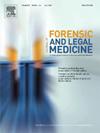Characteristics of alleged sexual assaults involving non-fatal strangulation at a Sydney metropolitan emergency department: a prospective descriptive study
IF 1.2
4区 医学
Q3 MEDICINE, LEGAL
引用次数: 0
Abstract
Background
Non-fatal strangulation (NFS) has the potential to cause serious harm and is increasingly common in sexual assault. The incidence may be higher than previously thought, underscoring the importance of screening. The aim of this study was to explore factors related to NFS in sexual assault presentations in a metropolitan Emergency Department (ED) in New South Wales (NSW), Australia.
Methods
A prospective review of the Medical and Forensic Examination Record (MFER) was used to retrieve data from patients at a metropolitan ED in NSW, Australia who underwent forensic examination for an alleged sexual assault, who reported NFS, between July 2021 and May 2024. Data were collected on these patients at the time of their review in the ‘NFS Checklist’ as well as the MFER. Parallel electronic medical records (eMR) were used to obtain information collected in the ED.
Results
Of 802 sexual assault presentations between July 2021 and May 2024, 113 (14%) cases involved NFS. 105 (92.9%) were female and 72 (63.7%) patients presented with ‘red flags’, the most common being dyspnoea (n = 43, 38.1%). Almost half of all cases (n = 49, 43.4%) had related physical examination findings. Over half (n = 64, 56.6%) of cases were referred to the ED, where 36 images were ordered, of which only one was abnormal. 25.6% of perpetrators were intimate partners.
Conclusion
NFS is common in sexual assault. More robust follow-up systems are essential. ED and Sexual Assault Services would benefit from implementing a protocolised triage and referral system which screens for red flags and domestic violence.
悉尼市区急诊科涉及非致命勒死的性侵犯指控的特征:一项前瞻性描述性研究
非致命勒死(NFS)有可能造成严重伤害,在性侵犯中越来越常见。发病率可能比以前认为的要高,这强调了筛查的重要性。本研究的目的是探讨在澳大利亚新南威尔士州(NSW)的一个大都会急诊科(ED)的性侵犯报告中NFS的相关因素。方法对医学和法医检查记录(MFER)进行前瞻性回顾,检索2021年7月至2024年5月期间在澳大利亚新南威尔士州一家大都会急诊科因涉嫌性侵犯接受法医检查的患者的数据,这些患者报告了NFS。在“NFS检查表”和MFER中对这些患者进行审查时收集数据。在2021年7月至2024年5月期间的802例性侵犯报告中,113例(14%)涉及NFS。105例(92.9%)为女性,72例(63.7%)患者出现“危险信号”,最常见的是呼吸困难(n = 43, 38.1%)。几乎一半的病例(n = 49, 43.4%)有相关的体检结果。超过一半(n = 64, 56.6%)的病例被转介到急诊科,那里有36张图像,其中只有一张是异常的。25.6%的施暴者为亲密伴侣。结论nfs在性侵犯中较为常见。更健全的后续系统至关重要。ED和性侵犯服务将受益于实施一个有协议的分类和转介系统,该系统可以筛选危险信号和家庭暴力。
本文章由计算机程序翻译,如有差异,请以英文原文为准。
求助全文
约1分钟内获得全文
求助全文
来源期刊

Journal of forensic and legal medicine
MEDICINE, LEGAL-
CiteScore
2.70
自引率
6.70%
发文量
106
审稿时长
57 days
期刊介绍:
The Journal of Forensic and Legal Medicine publishes topical articles on aspects of forensic and legal medicine. Specifically the Journal supports research that explores the medical principles of care and forensic assessment of individuals, whether adult or child, in contact with the judicial system. It is a fully peer-review hybrid journal with a broad international perspective.
The Journal accepts submissions of original research, review articles, and pertinent case studies, editorials, and commentaries in relevant areas of Forensic and Legal Medicine, Context of Practice, and Education and Training.
The Journal adheres to strict publication ethical guidelines, and actively supports a culture of inclusive and representative publication.
 求助内容:
求助内容: 应助结果提醒方式:
应助结果提醒方式:


